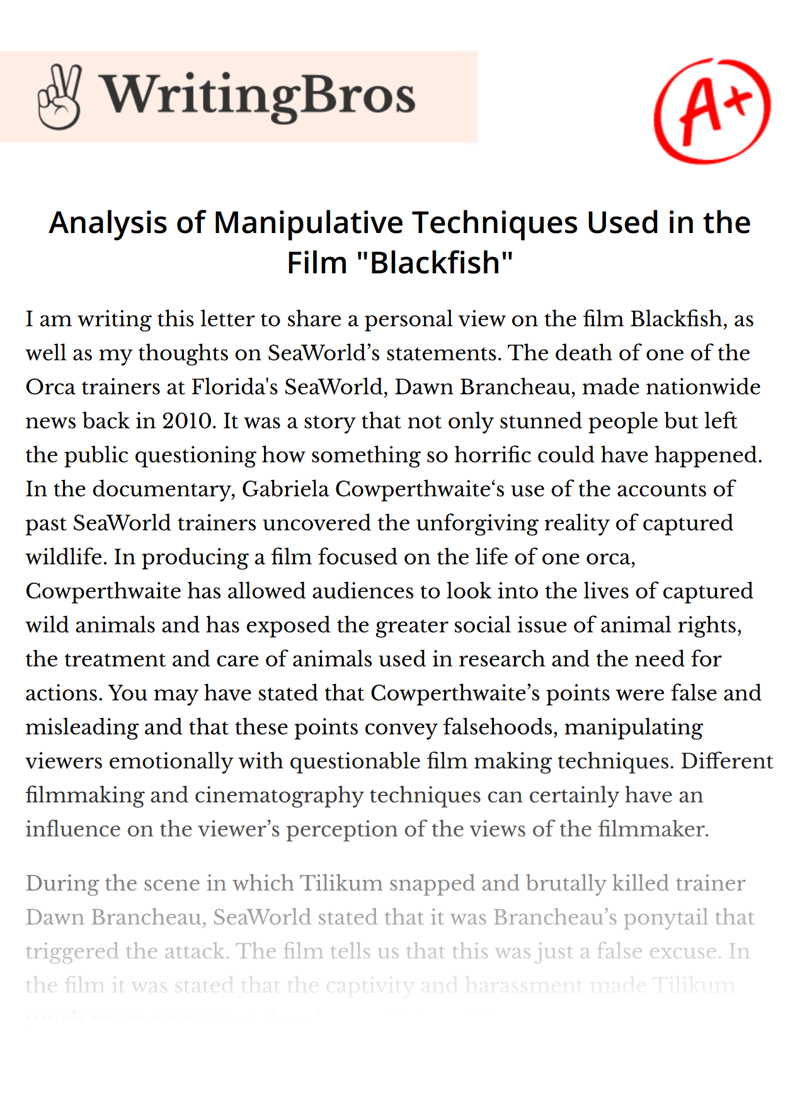Analysis of Manipulative Techniques Used in the Film "Blackfish"

I am writing this letter to share a personal view on the film Blackfish, as well as my thoughts on SeaWorld’s statements. The death of one of the Orca trainers at Florida's SeaWorld, Dawn Brancheau, made nationwide news back in 2010. It was a story that not only stunned people but left the public questioning how something so horrific could have happened. In the documentary, Gabriela Cowperthwaite‘s use of the accounts of past SeaWorld trainers uncovered the unforgiving reality of captured wildlife. In producing a film focused on the life of one orca, Cowperthwaite has allowed audiences to look into the lives of captured wild animals and has exposed the greater social issue of animal rights, the treatment and care of animals used in research and the need for actions. You may have stated that Cowperthwaite’s points were false and misleading and that these points convey falsehoods, manipulating viewers emotionally with questionable film making techniques. Different filmmaking and cinematography techniques can certainly have an influence on the viewer’s perception of the views of the filmmaker.
During the scene in which Tilikum snapped and brutally killed trainer Dawn Brancheau, SeaWorld stated that it was Brancheau’s ponytail that triggered the attack. The film tells us that this was just a false excuse. In the film it was stated that the captivity and harassment made Tilikum much more aggressive than he would have if he had remained in the wild. Of course, there is more to the argument than just Tilikum's hostility and what may have caused it, “If you were in a bathtub for twenty-five years, don’t you think you would get a little irritated, aggravated, maybe a little psychotic?”
Another issue is that SeaWorld made a false statement regarding the fact that orcas tend to live longer in captivity, with males living thirty years and females living fifty years, which are both very comparable to orcas in the wild. Blackfish, however, truly disputes this claim. Captive orcas will not actually live as long as their wild counterparts. While you at SeaWorld argue that captive whales live just as long in captivity, you did not produce data to prove this statement. More research would need to be done in order to determine if this claim was accurate. Blackfish strongly disputes the idea that captive orcas will live as long as those in the wild, and advocates for leaving wild animals in the wild where they belong.
Whenever Tilikum is mentioned, in any scene of the film but especially the scenes in which captivity is mentioned, aural signifiers are used. These aural signifiers used in Blackfish create a combination of fear and anxiety in the audience, manipulating viewers to feel sympathy towards the whale, as you hear it cry. The soundtrack alters between a deep, malicious tone, to a track that is positive, cheerful and optimistic. During a serious situation, for example, when critical statements were made about SeaWorld and orcas being kept in captivity, the soundtrack deepened. When the orcas were positively represented in the film, the soundtrack quickly changed to a positive, upbeat, bright and vibrant tone. This creates binary opposition between the graceful, content looking whales and the cruel captivity, manipulating viewer’s emotions. Jeffrey Ventre, a past SeaWorld trainer stated, “We saw whales swimming in straight lines with straight dorsal fins, and I was so honoured to be there…it was moving”. His voice weakens as he appears as though he’s about to cry. After so long working with these creatures in captivity, he is unmistakably moved to emotion by seeing them live favourably in their natural environment. Emotional music plays beneath lots of violin and stringed instruments. It has a ‘hopeful’ sound to suggest that there will be change. Another film technique used in these scenes was the use of a wide shot which places emphasis on the natural surroundings. Cowperthwaite was able to show the creatures in a wide, open space which contrasts to everything we have seen thus far (tanks, enclosed spaces). Viewers were persuaded by the documentaries codes to feel emotional at the conclusion of the piece, as it proposes inconclusively that all orcas indeed belong in the wild and visually shows just how much happier the orcas appear to be when left to their own devices.
It’s safe to say that the point of Blackfish was to perhaps manipulate viewers. Due to the manipulative effects used in the film, it’s to no astonishment that viewers, especially children and teens, have strongly criticized SeaWorld. An unending parade of hashtags, shameful demands, harassment of others, and the spewing of profanity. This sort of response to a shock-value film is not new, but it has set a novel precedent. Your views and beliefs surrounding Gabriela Cowperthwaite’s use of false and misleading points are not inaccurate, however, Cowperthwaite has been able to safely secure these points with accurate background information and evidence. I do agree that the film was able to emotionally manipulate viewers through a variety of different film techniques, however, I do not agree, or at least find it hard to believe, that it was anything false. The film was able to open eyes and hit hearts around the world, not just regarding SeaWorld, but the truth behind any animal kept in captivity. Thank you for taking time to read this letter and I hope you were able to understand my personal view on SeaWorld’s statements.
Cite this Essay
To export a reference to this article please select a referencing style below

